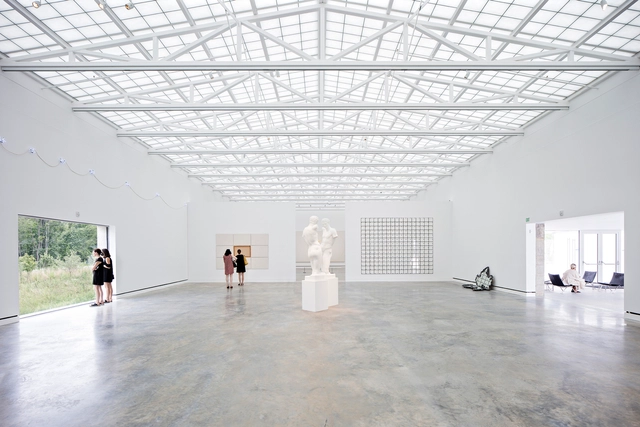In Louisiana Channel's latest interview, Indian architect Anupama Kundoo shares her thoughts on the importance of balancing between traveling and being in solitude with oneself. "I think travel is important, but if you're not rooted yourself, you will go to a hundred places and not see anything", explained the architect, "traveling helps you step back from what you take for granted".
Natural Ventilation Isn't the Most Efficient Solution in All Cases

Ventilation serves two main purposes in a room: first, to remove pollutants and provide clean air; second, to meet the metabolic needs of the occupants, providing pleasant temperatures (weather permitting). It is well known that environments with inadequate ventilation can bring serious harm to the health of the occupants and, especially in hot climates, thermal discomfort. A Harvard University study demonstrated that in buildings with good ventilation and better air quality (with lower rates of carbon dioxide), occupants showed better performance of cognitive functions, faster responses to extreme situations, and better reasoning in strategic activities.
It is not difficult to see that ventilation plays a vital role in ensuring adequate air quality and thermal comfort in buildings. We have all felt it. But when we talk about ventilation, a light breeze from the window might come to mind, shifting through our hair and bringing a pleasant aroma and cooling temperature that brings fresh air and comfort. In mild climates, this experience can even be a reality on many days of the year. In harsh climates or polluted spaces, it could be quite different.
CGC Student Hostel Landran / Charged Voids

-
Architects: Charged Voids
- Area: 135000 ft²
- Year: 2019
ArchDaily’s Readers Select Who Should Win the 2021 Pritzker Prize

Since the winner(s) of the Pritzker Prize 2021 will be announced on Tuesday, March 16th, we have asked our readers who should win the most important award in the field of architecture.
Loé House / Eduardo Martín Martín + Olympia Martín Gómez arquitectos asociados
Sharana Daycare Center / Anupama Kundoo Architects

-
Architects: Anupama Kundoo Architects
- Area: 766 m²
- Year: 2019
Multi-Sport Pavilion and Classroom Complex / Alberto Campo Baeza

-
Architects: Alberto Campo Baeza
- Area: 9000 m²
- Year: 2017
-
Manufacturers: BANDALUX, Ecophon
SOS Children's Village In Djibouti / Urko Sanchez Architects
.jpg?1441765217&format=webp&width=640&height=580)
-
Architects: Urko Sanchez Architects
- Year: 2014
Residence 1065 / Charged Voids
The House of the Infinite / Alberto Campo Baeza

-
Architects: Alberto Campo Baeza
- Area: 900 m²
- Year: 2014
-
Manufacturers: BANDALUX, panoramah!®
-
Professionals: Chiclana, Laboratorios Cogesur
House - Concepts

“A House is a place (…) as physical as a set of feelings. (…) a home is a relation between materiality and mastery and imaginative processes, where the physical location and materiality and the feelings and ideas are united and influence each other, instead of being separated and distinct. (…) a house is a process of creation and comprehension of ways of living and belonging. A house is lived, as well as imagined. The meaning of house and the way it materially manifests itself, it´s something that is created and recreated in an unceasingly way through every day domestic tasks, which are themselves connected to the spacial imaginary of the house”1
The sentence above is the starting-point of the current reflection, in an exercise that will mark meaningfully my approach to the way of projecting houses.
The House of Jesus / Rubens Cortés Arquitectos + Raúl Rodríguez Ruiz (RRR)

-
Architects: Raúl Rodríguez Ruiz (RRR), Rubens Cortés Arquitectos
- Area: 266 m²
- Year: 2017
-
Manufacturers: Elesdopa, Porcelanosa Grupo
Swahili Dreams Apartments / Urko Sanchez Architects

-
Architects: Urko Sanchez Architects
- Area: 1600 m²
- Year: 2014
-
Manufacturers: Hussein Safina, Kuresh
-
Professionals: Continental Homes
Spotlight: Alejandro Zaera-Polo

Alejandro Zaera-Polo (born October 17th 1963) is an internationally recognized architect and scholar, and founder of London, Zurich, and Princeton-based firm Alejandro Zaera-Polo & Maider Llaguno Architecture (AZPML). First rising to prominence in the 1980s with his writings for publications such as El Croquis, Zaera-Polo has had a prolific career in both the academic and professional realms of architecture.


.jpg?1618576449)

.jpg?1618576436)

.jpg?1618238885)


.jpg?1618238951)

.jpg?1612830461&format=webp&width=640&height=580)
.jpg?1612830606)
.jpg?1612830729)
.jpg?1612830666)

.jpg?1612830461)










.jpg?1441765207)
.jpg?1441765537)
.jpg?1441765440)
.jpg?1441765385)
.jpg?1441765217)







.jpg?1606397161)















.jpg?1585773323&format=webp&width=640&height=580)















